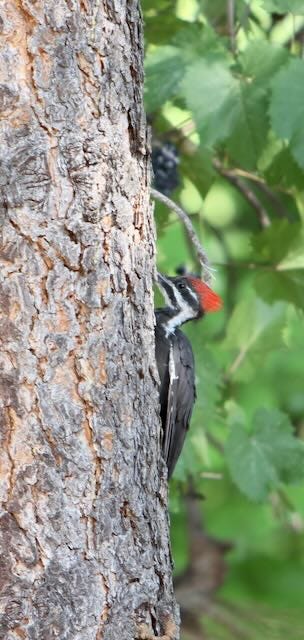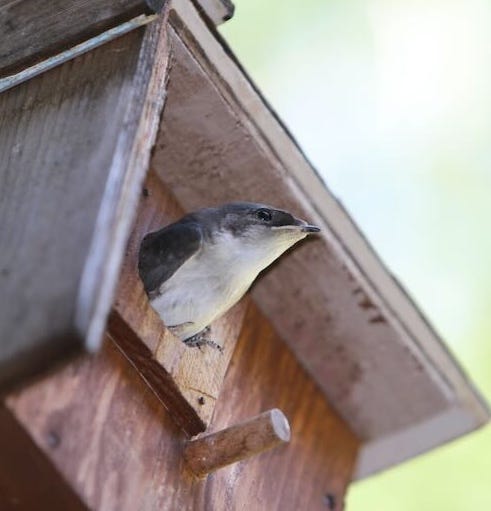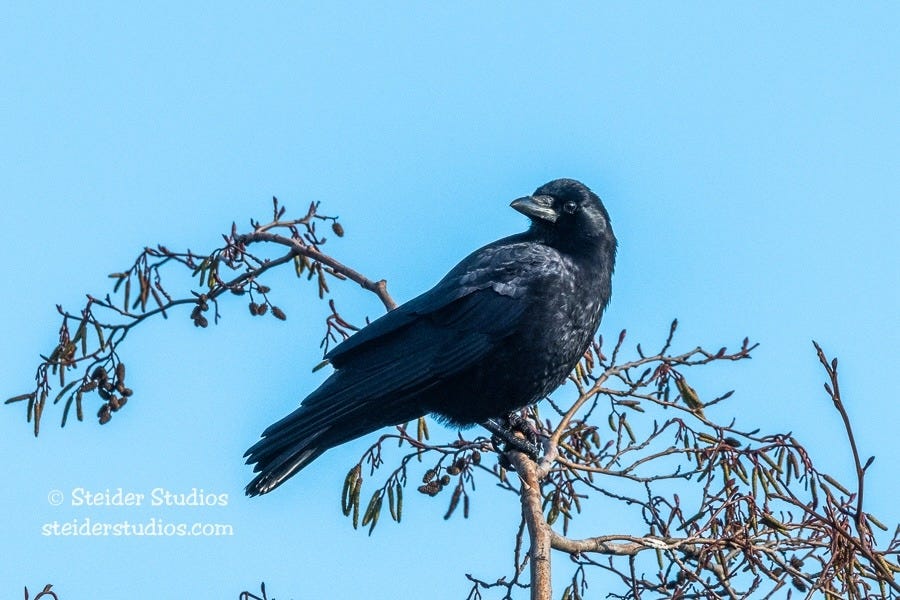Wild Stories is a monthly newsletter in which I write about an animal, a plant, a landscape, or a natural phenomenon. I have engaged with nature for decades through observation, physical experience, and study. Many species and ecological environments are threatened by habitat loss, climate chaos, and a lack of legal protection and kinship with the natural world. With Wild Stories, I share a bit about the lives of our flora and fauna and the incredible landscapes we live in.
“Make sustained contact with something undomestic, sacred, and tremendously powerful. Something for the good. Something filled with bone. Fall in love with it. This first covenant supplies energy, rapture, joy.” ~ Martin Shaw, Writer, Mythographer, & Storyteller
There’s been a lot of drama at my birdfeeders this winter. Members of the chatty Corvid family - jays, crows, and ravens - strategically storm my feeders, working amidst a nervous hierarchy with each other. The smaller songbirds - dark-eyed juncos and black-capped chickadees - mostly avoid the drama and flit about in the nearby shrubs, waiting for a bit of seed to drop or an accessible flight pattern to one of the birdfeeders. One morning, I peered out my front window and saw a Northern Flicker clinging to the side of a suet cage, and all other birds had moved away from the flicker. I wonder if the flicker knows her power?
I began bird watching back in the 1990s. A local Audubon chapter offered walks and bird identification classes, which helped me learn the basics. Over the years, I’ve participated in several birding excursions - a pelagic tour on the Pacific Ocean, where I discovered just how seasick one person could become, and a SE Arizona tour during the spring hummingbird migration, one of the best group nature explorations I have experienced.
Birding as a daily practice is one way I maintain my kinship with the natural world. It engages my visual and auditory senses, demands focused attention, and compels me into a momentary stillness. Walking is usually leisurely, with frequent stops to listen, look, and identify birds and their distinctive bird voices. During the colder months, with a good supply of bird food and several feeding stations, I can bird from the warmth and comfort of my home. Last fall, I strategically located my feeders so that I could see them from my living room windows. In my pajamas and robe, seated comfortably in my favorite chair, I use binoculars to observe my visiting birds' eating and territorial behaviors.
When I observe birds throughout the year, I witness some fascinating moments. On a warm autumn afternoon, I watched two pileated woodpeckers drunkenly fall off their perches and hang upside down after repeatedly eating what I suspect were fermented grapes. I spent a hot afternoon on a covered porch watching hungry young swallows fledge from a nest box for the first time, patiently coaxed by their parents who ignored the nestlings’ demands to be fed.
The Merlin birding app has dramatically changed access to birding: it can identify birds you can’t see but hear.1 In spring’s cacophony of early morning birdsong, I stand in my pajamas and robe on my front porch, binoculars around my neck and phone in my hand, and watch the app build a list of identified birds heard but mostly not seen.
There are stereotypes about birders, but this new short documentary (14 minutes) challenges them and features four women who love watching birds.
Scientific research supports what we already know: We feel better when we engage with the natural world. University of Washington environmental psychologist Gregory Bratman, who led a recent review of social and health sciences findings, asserted: “Evidence is there to support the conclusion that contact with nature benefits our mood, our psychological well-being, our mental health, and our cognitive functioning.”
In these times of great distress and global suffering, I believe in nature's power to soothe our souls, calm our minds, and spark wonder and joy. This is why I am writing Wild Stories.
Corvid Family
Some of the most familiar birds humans are likely to encounter are species in the corvid family (a group that includes crows, ravens, rooks, magpies, and jays). They are widely distributed throughout six continents in urban, suburban, and rural habitats. Corvids are woven into our history of creation stories, trickster myths, literature, and scientific research.
Worldwide, there are about 139 species in the Corvidae family and 40 in the Corvus genus. Corvids are among the most intelligent animals, keeping company with dolphins, chimpanzees, and two-year-old toddlers.
Ravens and crows have been observed doing the following:
Making tools from sticks to retrieve food
Untying knots in strings to retrieve food
Stealing bait and fish from an untended fishing rod
Digging newly planted seeds after observing them being planted (explaining how the scarecrow was invented)
Recognize patterns, voices, and faces
Maintain long memories and grudges over several generations
Count up to four
Mimic human and other animal sounds
Plan for the near future by hoarding food
And in one fascinating study…learned to use a crow “vending machine,” depositing tokens to purchase peanuts.2
Corvids are socially monogamous, meaning they mate for life but, like several other species, are genetically promiscuous, indulging in additional hanky-panky outside of their mated relationship.3 Once mated, the couple seeks a new territory similar to the one they were raised in (urban, rural, suburban), where they may reside for years.
Many Corvids live in small family structures; their young ones often stay for several years, helping with younger siblings and learning the Corvid way of life. Some species utilize communal roosting at night as a protective strategy - hundreds, even thousands of crows gather into a grove of trees to spend the night.
I see three species of Corvids in my northern rural homestead.
Stellar’s Jay (Cyanocitta stelleri)
Range: West of Rocky Mountains, SE Alaska to SW desert
Habitat: Permanent resident of pine forests of the west; suburban parking lots, backyard feeders, and campgrounds
These birds are easy to identify with their cobalt blue coloring and distinctive black crest topping their head. The crest feathers move up and down, providing insight into the bird’s mood and activity. When foraging or drinking, the crest is relaxed, laying low. The crest is raised when a jay feels nervous or faces an aggressive encounter.
They are the most frequent visitors to my birdfeeders, always announcing their arrival with raucous calls. They have adapted well to human activities, magically showing up when the birdfeeders have been newly refilled and selectively foraging my compost bins. They’re nicknamed “camp robbers” because of their ability to find unattended human food in campgrounds. They tear into bags of chips on picnic tables and scavenge crumbs or food on the ground. (Note that human food is never good for wildlife.) I think their best trick is mimicking the well-known call of the Red-Tailed Hawk; small birds scatter when they see or hear predators like a hawk, eagle, or raven…opening up the bird feeders for the jays’ sole enjoyment.
Ravens (Corvus corax)
Range: Alaska, across Canada, and throughout the western US, extending into Mexico
Habitat: mountain forests, tundra, farms, grasslands, deserts, suburban areas
Ravens occasionally visit my birdfeeders, but I am more likely to see them flying or hear them in the tall conifers. They are the largest Corvids: big, chunky, shaggy neck, 2 ft tall, 4 ft wingspan, diamond-shaped tail, and glossy black coat that can look purple in bright sunlight. They are gregarious, playful, intelligent birds with a guttural croaking call.
Their thick, hooked beak is designed for tearing and eating carrion. Opportunistic eaters, they predate songbirds, eggs, nestlings, and rodents. Biologists consider them subsidized predators because they have adapted well to human-altered habitats and activities. As a result, their populations have increased fourfold (and more in some places) over the last five decades. This population growth has had detrimental effects on threatened species like the sage grouse. Several Western states have developed management of ravens by systematically killing them. 4 Like most of our ecological problems, it is complicated by human misuse and abuse of our ecosystems.
Several indigenous cultures call ravens “wolf birds,” acknowledging a long-observed relationship between wolves and ravens. Current research is investigating this unique partnership: do ravens help locate prey for the wolves? Or do they keep in touch with a wolf pack to benefit from the kill?5
American Crow (Corvus brachyrhynchos)
Range: Throughout most of the lower 48 states
Habitat: Primarily urban and suburban settings: lawns, parks, garbage dumps, campgrounds, fields
I don’t see many crows in my rural landscape because crows followed human migration to the cities where they have flourished. They are the most widespread and likely the most numerous Corvid. As omnivores, they forage on the ground, eating insects, worms, small mammals, bird eggs & nestlings, roadkill, and garbage. They typically don’t visit birdfeeders but can be trained to do so, but be careful what you wish for! They can become nuisances, and some cities utilize various strategies to discourage the crows from roosting in their communities.
Smaller than a raven, they have thinner beaks, narrower necks, and fan-shaped tails. Their calls (caw-caw-caw) are more frequent and higher-pitched than a raven's.
Crows are highly social and large groups, numbering in the hundreds and thousands, often roost communally in the tops of trees. They are bold and aggressive - Remember the terrifying mobbing scene from Alfred Hitchcock’s movie The Birds? A long-term study showed that crows remember the faces of humans they deem a threat or guilty of a past injustice. 6
Thank you for being here. All of my posts are free, but if you’d like to support my work, you can do so by:
Liking and restacking this post so others are encouraged to read it.
Share this post via email or on social media.
Taking out a paid subscription to this Substack.
Can you identify five bird species that show up regularly in your life? Mine are wild turkeys, Anna’s and rufous hummingbirds, Stellar’s jays, robins, and ravens. Another five are violet-green swallows, red-tailed hawks, dark-eyed juncos, Great Horned owls, and two species of chickadees. Can you recognize them by sight and sound? Do you have stories about birds? Share your thoughts in the comments.
Linda Steider is a professional wildlife photographer who has generously shared her beautiful photos for my Wild Stories essays. Visit her website, steiderstudios.com, to see her portfolio of wildlife photos.
From Linda’s website:
The more time I spend in nature, the more I want to be there. I aim to capture everything I see with a photograph so you can see it, too. My passion is wildlife, and I want to show you the life and personality of each subject I find so you’ll care for it as much as I do.
My ultimate goal is to share nature with people who can’t see the magnificence of our natural world for themselves. Not just shut-ins, wheelchair-bound, too infirm, or too young, but also those who spend all their time at work or home caring for others. I especially want people who can’t get out to know how spectacular nature is, in our backyards and beyond.
I have many images available for prints on paper, metal, and canvas, as well as all-occasion greeting cards, bookmarks, mousepads, ornaments, and magnets. You can order prints in most standard sizes on any media.
Download this free app on your phone. https://merlin.allaboutbirds.org/
https://corvidresearch.blog/2015/03/05/all-in-the-crow-family/#Mono
https://www.hcn.org/issues/46-12/are-we-smart-enough-to-solve-our-raven-problem/
https://www.yellowstone.org/naturalist-notes-wolves-and-ravens/
Crows, Smarter Than You Think - TED Talk I highly recommend watching this engaging talk by one of the most renowned crow researchers, John Marzluff.













Sue, what perfect timing! I was at my writing desk early this morning when a parade of birds began appearing. Cardinals, Blue Birds, Brown Thrashers, and more. They were enjoying the seeds from a stand of longleaf pines out back. In just 5-10 minutes of observing them, I felt completely recharged to get back to the work of creating. It never fails.
Corvids are so fun to watch! Thank you for this interesting post and for Linda Steider's photos. She is an amazing photographer with an excellent eye!
Five birds: magpie, flicker, red-tailed hawk, crow, raven
Five more birds: mountain bluebird, meadowlark, junco, chickadee, killdeer
Five more: Canada geese, blue heron, house wren, cliff swallow, robin (so obvious I almost forgot!)
An excellent book by Marina Richie, "Halcyon Journey, In Search of the Belted Kingfisher" is a wonderful read about her dedicated study of the belted kingfisher. Highly recommend if you like birds!